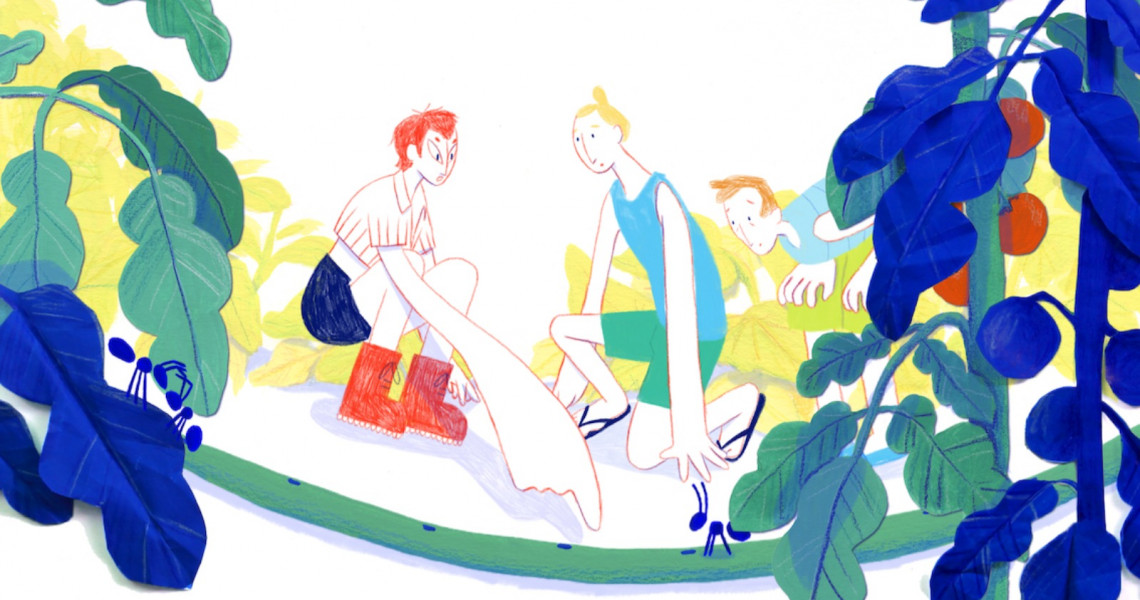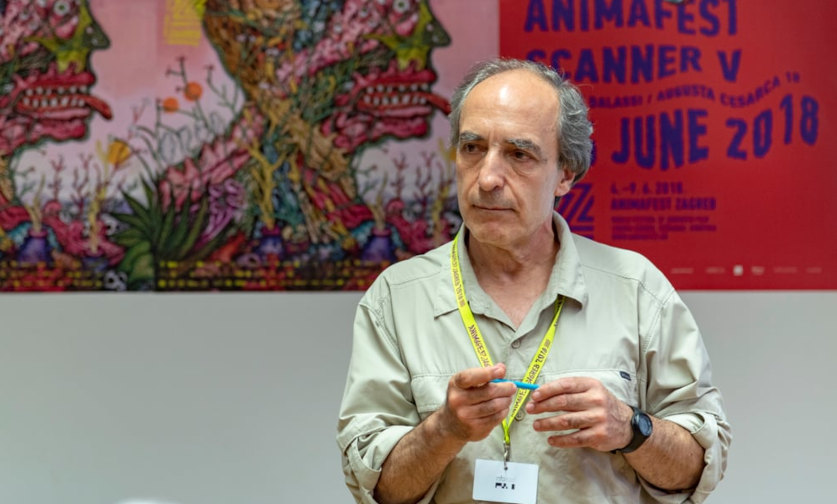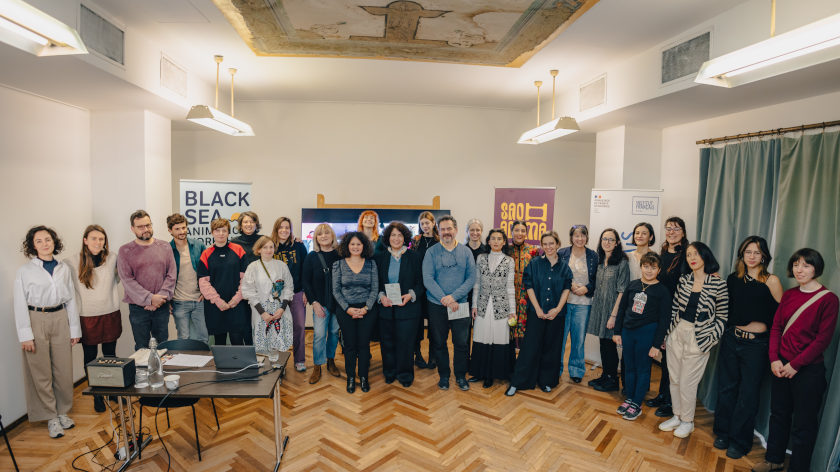Phidias the Animator: Movement Analysis in the Parthenon’s Frieze
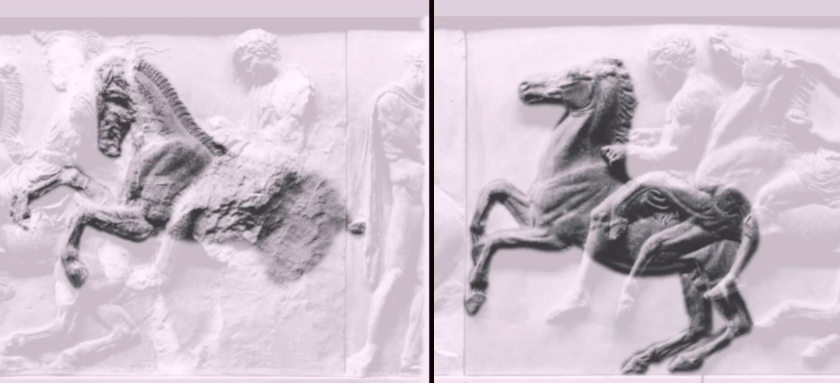
(Guest Article)
It is widely acknowledged that Phidias was one of the greatest sculptors of Classical Greece. However, what has not been realized is that he was also an expert on movement analysis. Phidias was a very good animator over two thousand years before the animation cinema. This knowledge was used in the conception of the frieze of the Parthenon, as a basic structural feature.
The Parthenon was built in Athens between 447 and 432 BC. Phidias sculpted on it a frieze in low relief, about 160 m (525 ft) long and 1.05 m (3.45 ft) high. Experts see it as a representation of the great Panathenaic procession, a celebration in honour of goddess Athena. The action begins at the rear of the Parthenon in the western section; it continues along the northern and southern friezes and ends at the eastern frieze.
If one looks at the figures of the Parthenon’s frieze carefully, they will realize that there is continuity and connections between the figures which look like the key positions of an animation film. We can examine a simple example found in the west frieze where two figures perform a similar action: both tie the laces of their sandals.
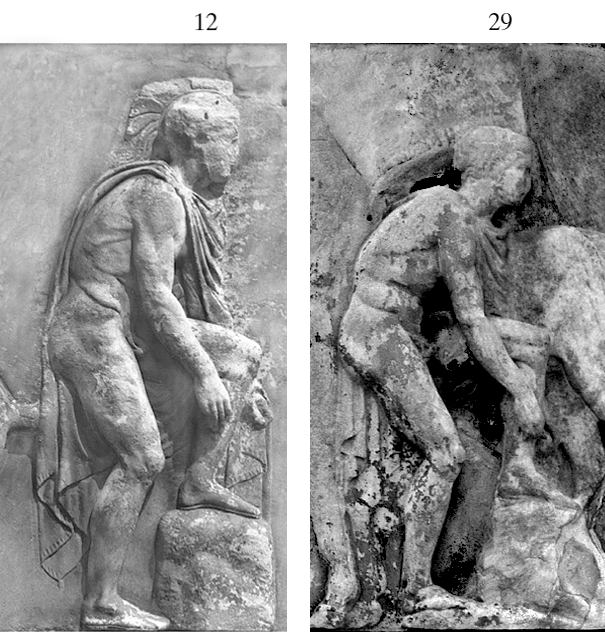
If we superpose character 12 to that of 29 and alternate the two images, we will obtain the movement of someone who pulls up his laces.
The cattle’s revolt
The idea of Phidias’ use of key positions is evident in another scene: if we look at the cattle led to sacrifice in the south frieze, we can detect a similar use of action analysis to the composition of the scene.

Even though some animals are damaged here, the result of this animation process is a very convincing representation of the vigor of a strong animal that fights for its freedom before it surrenders to the power of its guards.
In this animal movement, we can also observe that there are coherent reactions of the people accompanying the cattle. In a way similar to the animal movement, the human figures also represent the key positions of the movement of a man’s action, that is, the action of somebody who controls the agitated animal.
Time and space are related in a movement. If somebody jumps, an animator knows by experience precisely how long he can stay in the highest position. Thus if we superpose the figures and allow for the time needed for the completion of the movement, we can realize that the difference between every position is about 1/5 to 1/4 of a second, as can be verified in the animation film. On the basis of the logical coherence of the action analysis, we can even suggest the necessary positions for the missing, destroyed figures.
The god’s subliminal gesture
In the eastern section, action converges towards the centre, where the scene of the offering of the peplos to the goddess takes place. The gods of Olympus are seated to the left and right of this scene. In a more significant animation, the gods in the east frieze Athena, Hephaestus, Poseidon, Apollo, Artemis, Aphrodite and Eros, have positions indicating their identity.
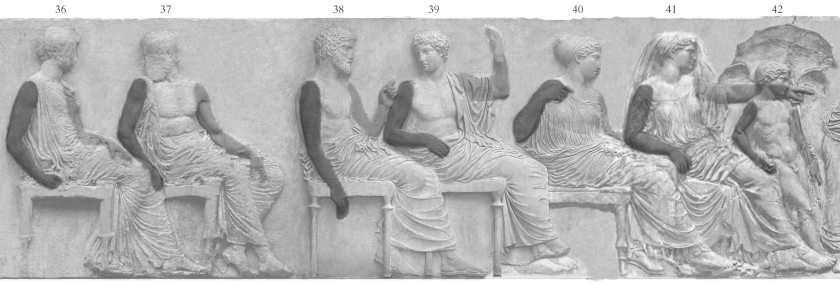
Poseidon holding a trident (originally drawn but now missing), Artemis adjusting her gown in a gesture reminiscent of an archer who has just shot an arrow, and so on. However, looking at the same figures as a whole, we can deduce that their arms are organized in a sequence, passing successively through key stages of a concrete action: pointing to the right. From Athena’s relaxed position, movement falls in anticipation at Poseidon, and rises gradually to reach the outstretched arms of Aphrodite. Animating these key positions gives the action of pointing.
We can see again that there is consistency in the movement, and this consistency has great significance as the place to which the arms point is the arrival of the procession on the frieze. Thus we see a double representation, both by individual postures and the collective action of the figures.
The apovatein demonstration
Preceded by impressive rows of knights on the northern and southern walls, we see the representation of the “apovatein” demonstration, during which a young soldier jumps from a running carriage, runs by its side, and then jumps back on it. This action is depicted in the North, but unfortunately with many parts missing. For some of them we have precious indications from rough drawings sketched a few years before their destruction.
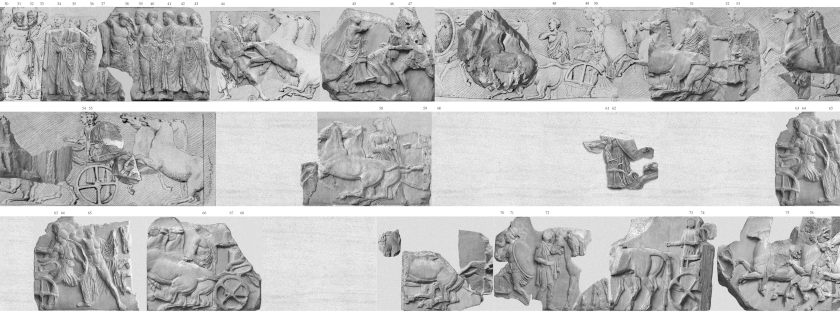
For some others we can deduce their position following Étienne-Jules Marey’s chronophotographies: All articulated systems, such as the human body, evolve through curve trajectories. The result is a possible reconstruction of this action.
The rearing horse
We can find another complex and detailed animation in the western part, where there are scenes of the preparations. If we superimpose ten of the juxtaposed horses, we can see that we are in front of a representation of the stages in the movement of a rearing horse.
It is important to note, once again, the precision of the movement of the horse. We now know that the transmission of weight from the hind legs to the front legs is diagonal in horses. This is not the case with all animals. It is important to note that Phidias applies this transmission diagonally in this example.
The principle of implicit movement
The above observations lead us to suggest that the implicit movement connecting the different figures is an intentional general principle rather than something accidental. The question which arises is why use this “between-the-lines” representation. At that time, the cosmos was perceived as a perfect and harmonious entity. This conception is the source of the ethical duty to be integrated in this harmony. The greatest evil, the hubris, is the excess, the rupture of this harmony of the cosmos. The debate of ideas in the agora was an everyday practice at that time. A great number of philosophers of different views were active when the Parthenon was constructed: Zeno, Anaxagoras, Protagoras, Gorgias and Socrates. Others had preceded such as Parmenides, Heraclitus, Pythagoras and Thales. Plato, Aristotle and Epicurus were born later, but the foundations of their thought were already there. Dialectics, the process of reasoning which seeks the truth by comparing opposing views, is initiated at that time by Zeno of Elea. The synthesis of opposites is taught by several philosophers: Pythagoras, Heraclitus, and Socrates, especially his maieutics. The oxymoron, a figure of speech that combines two opposing concepts, as in the famous proverb σπεύδε βραδέως (more haste, less speed) is an illustration of that dialectical spirit which derives its sense from contradiction.
A reference “philosophical” object
The frieze was set so high that it was hardly visible. But we know that the principle “what is visible exists” was not applicable at the time. For the ancient Greek, the search for harmony was considered a value in itself, regardless of its visibility. For instance, the back of the statues on the pediments were completed carefully even though it was very clear that they would not be visible. The frieze represents events which every Athenian of the time either witnessed or participated in, as the procession was held every year with a more important one taking place every four years. So, viewers of the time knew the representations on the frieze as an opera audience today often knows the libretto by heart and only needs to be reminded of it from time to time. It could be suggested that this representation is not made in order to be viewed, but in order to be used as a reference object. Rather than appearance (to appear), it is the truth (being) that is being sought.
In addition to and beyond the illustration of the Panathenaic procession, there is another narrative evolving through the structure, by the subliminal movement created through the carefully chosen postures of the figures. This implicit action represents the fundamental principle of the city, the model of a social structure that works dialectically by synthesis after debate and collaboration among its citizens. The issue in this narrative is the spirit of Athenian democracy and its conception of the cosmos. Here the narrative takes the form of a paradigm, a model that mimics a function, where meaning emerges only as a result of various representations. It is a dialectical object - and thus necessarily polyphonic - where a spectator is inevitably implied. The rhetoric of the frieze, just like the “maieutics” of Socrates, leads the viewer to reach his own conclusion. Phidias provides a beautiful score; it rests on the informed viewer to interpret the music. The term symphony has been used for more than a century in connection with the frieze, without however explaining the reason for this qualification.
This composition in bas-relief, in fact -literally- corresponds to a musical score, consistent with the spirit of this period of Antiquity, when everything was steeped in music. The symphonic composition creates an experience rather than illustrates a subject. This is an uncommon form of poetic narrative of philosophical content. By movement analysis/synthesis, we do not have a metaphorical form, but a metaphorical representation of structure. We believe this representation of structure is a philosophical object, designed to be looked at mentally rather than visually. A holistic vision coupled with an ethics, of which the need is strongly felt today, in the face of the multiple ecological disasters that are looming, precisely because of the excessiveness of our anthropocentric ideologies, which begin at the time of the creation of the frieze, with the sophists and the proclamation of Protagoras: "Man is the measure of everything”...
Note: The original photos are of Socratis Mavrommatis. Some parts are restored digitally by the author, to facilitate perception of continuity of the relief. In some cases, we replaced parts with Fauvel’s casts. Drawings in the apovatein demonstration come from the Anonymous (1674).
Contributed by: Georges Sifianos





